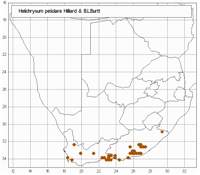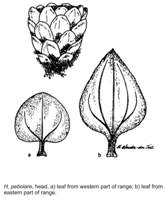Common names:
Licorice plant (in California)
Origin of name:
petiolare = with well-developed flower stalk
Diagnostic characters:
Leaves with petiole, covered in hairsLarge headsLarge compact branched inflorescenceLight yellow/greenish bracts
Description:
A straggling, loosely branched, soft-wooded shrub forming tangled masses several meters across and as high when supported by other vegetation, branches long, slender, thinly grey-woolly, leafy becoming pedunculoid and distantly bracteate below the inflorescences. Leaf blades mostly 10�35 x 10�30 mm, subrotund to broadly ovate or elliptic-rhomboid, apex rounded, base truncate, subcordate or cuneate, both surfaces grey-woolly-felted, upper sometimes only cobwebby, petiole up to 10 mm, flat, sometimes winged, base auriculate. Heads homogamous, subglobose opening broadly campanulate, c. 5 x 5 mm, many in loose terminal corymbose panicles. Involucral bracts in c. 5 series, graded, loosely imbricate, about equaling the flowers, radiating, backs loosely grey-woolly above stereome, tips rounded, concave, opaque milk-white. Receptacle with fimbrils equaling or exceeding ovary. Flowers 18�30, yellow, sweetly scented. Achenes 1 mm long, barrel-shaped, 5-ribbed, glabrous. Pappus bristles many, scabrid, about equaling corolla, bases cohering strongly by patent cilia, lightly fused as well.
Flowering in December and January.
Distribution:
Grows in shrubby places in damp sheltered kloofs and on forest margins. Ranges from the Cedarberg and the mountains near Stellenbosch to the S. Cape coast forests, thence NE. to Insizwa and Tabankulu Mountains in the Transkei, at about 900-1 050 m in the SW. Cape, but descending to lower altitude in the coast forests, then between c. 1 050 and 1 400 m from the Amatola Mountains and nearby to the Transkei.
Fynbos, Thicket, Savanna and Grassland Biomes.
Notes:
H. petiolare is distinguished from its close allies, H. patulum and H. pandurifolium, by its flat, not crisped-undulate, leaf margins, and from the latter also by its more obtuse, concave involucral bracts.
In the NE. part of the range (roughly Katberg, Hogsback and King William's Town to the Transkei), leaves tend to be rhomboid-elliptic and only cobwebby above, not ovate to subrotund and grey-woolly-felted as they often are in the western part of the range. Specimens from Suurberg Pass, Storms River and Komadagga are more or less intermediate in shape and cobwebby above.
Planted in many areas of the world as bedding plants for attractive grey foliage. Considered as an invasive in California. Naturalized in Portugal.
Taxonomy:
Literature:
Helichrysum petiolare Hilliard & Burtt in Notes R. bot. Gdn Edinb. 32: 357 (1973); Clapham in Tutin et al, Fl. Europ. 4: 131 (1976).
Type:
Cape, Zuurberg, Dr�ge 264 (G-DC, holo.).
Synonym(s):
Gnaphalium tomentosum, foliis orbiculatis subtus incanis Burm., Rar. Afr. Pl. 214, t. 76, fig. 2 (1739).
H. petiolatum sensu DC., Prodr. 6: 208 (1838) quoad descr. et spec., excl. syn.; Harv. in F.C. 3: 252 (1865); Moeser in Bot. Jb. 44: 312 (1910); non (L.) DC.
Vouchers:
Compton 23115 (NBG); Fourcade 561 (BOL; PRE); Galpin 2909 (PRE); Hilliard & Burtt 6503 (E; K; MO; NBG; NU; PRE; S).

 QGee_sml.jpg)